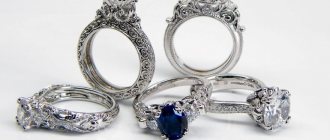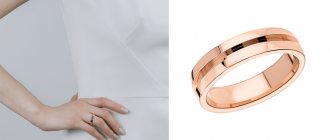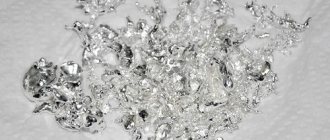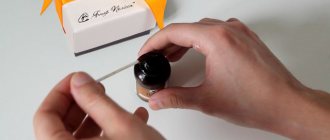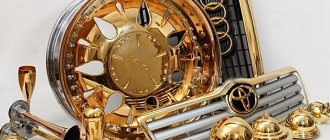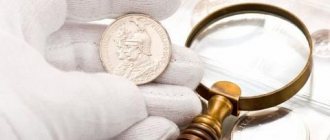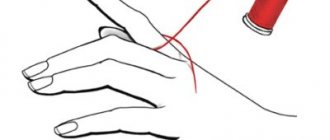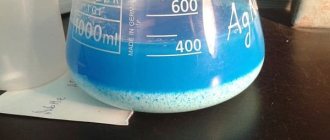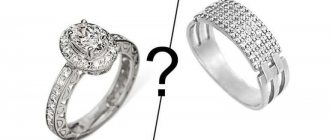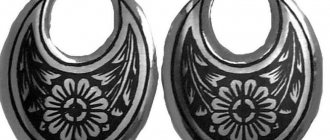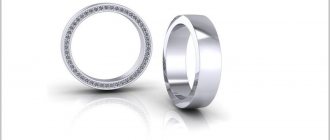How to remove gold plating from silver yourself?
Gilding is a gold coating on a silver product, which is performed in two ways: fire gilding and electrolysis.
Fire gilding was banned back in the 19th century because the process released mercury vapor, which led to blindness. Modern gilding is done using electrolysis, and in order for a product to be considered gold-plated, it must be covered with a layer of gold of at least 385 and a coating thickness of at least 2.5 microns. Professional jewelers use grinding, acid, and other procedures to remove gold plating. If you want to do it yourself, you can resort to less effective at-home methods using gentle hand cleaning with certain cleaners and polishes.
1. You will need a fine-grained sandpaper or a brush with natural bristles. Rub the item vigorously to remove the gold plating. If necessary, apply a paste of baking soda and water to the sandpaper or brush to increase abrasiveness. Depending on how uneven the surface of the piece is, this process can take a long time, but as a result, gold may still remain in the folds and depressions.
2. If there are very small irregularities, also rub them with a toothbrush. Carefully remove any grains of gold plating remaining in the corners with a needle. Be careful because the needle may scratch the silver underneath the gold, which will require professional repairs from a jeweler.
3. To restore the shine of the silver that was under the gold plating, polish it with a polishing paste such as Tripoli and a felt cloth. Although silver is harder than gold, the process of removing the gold plating will leave scratches and possibly nicks. Polishing pastes vary, so it's best to consult a jeweler before you begin polishing. Polishing too hard can also leave scratches. It's best to start with a medium-strength polish.
4. When finished polishing, rub the piece with red polish and a soft cloth to restore the shine and shine of the silver. Be patient and rub thoroughly.
5. Finally, buff your silver piece with a soft cloth and a good quality silver polish. If after this you do not like the appearance of the item, you will have to take it to the jeweler to complete the procedure.
— Instead of baking soda, you can use metal polish, especially if the gold plating is very thin. Commercial polishes usually leave the silver in better condition and help restore its shine.
Source
How quickly does gold plating wear off?
Visually, gold-plated silver is no different from gold. But the first one is not suitable for daily wear. When gilding, the metal binds to the surface being treated at the molecular level, so the only impact under which it can be erased is mechanical. Some people think that contact with water will cause the gold plating to come off, but this is not the case. Gold-plated jewelry, along with gold jewelry, is highly susceptible to scratches.
Thus, the service life of gilding also depends on how carefully you store and wear the product. In addition, the thickness of the gold plating, unfortunately, can also be different and range from 0.05–0.5 microns.
How long the coating will remain on your jewelry depends on how you wear it. If you buy a product in a specialized store and have all the quality certificates, then you can enjoy such a product for at least two years. At the same time, on pendants and earrings - jewelry that does not come into contact with the skin so often, the coating will last much longer.
If the gold plating is worn off, it can be easily restored. But if you want the product to become silver, then you will need to know how to remove the gold plating.
Service life of gilding on products
Not only women, but also men love gold jewelry. But not everyone can afford to purchase a product made of pure gold. For such people, there are other jewelry that is less expensive. They are made of silver, but the gilding used for coating makes the product visually similar to gold.
If such jewelry is not examined in detail, it can easily be mistaken for real gold. A counterfeit can only be detected by cutting or using special chemical reagents. This is convenient for clients, but is it worth saving without knowing how long such decoration will last and whether it will lose its appearance over time?
Gold-plated products are in great demand due to their affordable price and visual resemblance to real gold. But if the wearing rules are not followed, the gilding can quickly wear out and will have to be restored.
Gold plated item
The service life of gilding directly depends on the owner - on how he will wear his jewelry and monitor its condition. There are several simple rules, the observance of which will allow you to preserve the gilding on jewelry for a long period of time:
- You should not sleep with gold-plated items on; before going to bed, it is better to remove them and put them in a box or on the nightstand.
- During physical labor, it is better to remove gold-plated jewelry. When interacting with sweat, the gilding is destroyed.
- There is no need to wear gold-plated jewelry on your hands when working with chemical elements. These are not necessarily aggressive substances used by chemists. Simple washing or washing dishes using special products has a detrimental effect on gold plating.
- It is also recommended to remove gold-plated rings when working with soil in the garden or with various materials that can scratch the top layer of the product. It must be remembered that gold-plated objects scratch faster than gold ones, and this is clearly visible on them.
- It is important to properly clean products when necessary. There are many methods that can be used at home. For example, soak it in beer for half an hour, and then rinse thoroughly in water. You can dilute detergent and ammonia in water and keep the jewelry in this solution. But it is important not to overexpose it, because ammonia corrodes the gold, and it is better to use it only if it is heavily soiled.
If these rules are followed, a gold-plated product can serve for many years without changing its appearance. It is better to wear it only when you are going to visit or receive guests. The rest of the time it is better to store it in a box.
But the service life of gilding also depends on the standard of the metal that is used for it. In Russia, a sample of 999 or 750 is used for this, less often 585. This is a fairly high sample that allows it to be preserved on the product for a long time. Foreign jewelry is covered with less high-grade material, so it lasts less.
Subtleties of product care
There is an opinion that gold-plated jewelry is impractical because the coating wears off quickly, causing the product to lose its attractiveness. This is a misconception - high-quality earrings or chains cannot lose their original appearance, for example, after several trips to the shower.
In order for jewelry to please the owner for as long as possible, it is necessary to properly care for gold-plated silver items:
- It is advisable to remove rings, earrings and chains before going to the bathroom. Soapy water and a towel are not the best friends of jewelry, as they lead to a rapid loss of shine and darkening. But it is worth noting that real gold-plated silver cannot quickly deteriorate just from water. If this happens, there is no doubt that the product was initially of poor quality.
- You should not wear jewelry before training. During sports, a person sweats profusely, and sweat, when it gets on gold-plated items, contributes to the loss of their attractiveness. The same applies to any work that requires significant physical effort.
- Jewelry must be stored in a box. At the same time, you need to make sure that the jewelry does not come into contact with each other - this way they will quickly get scratched.
- Every evening, wipe rings and earrings with a piece of suede cloth. This technique will help keep the products in their original form and avoid more radical cleaning methods.
Methods for removing gold plating
There are several ways to remove gold plating from the desired item. It is important to understand that if we remove an unnecessary layer from a piece of jewelry, trying to bring it back to its divine form, we can do this at home. But if high-quality processing is necessary, it is better to trust an experienced specialist.
The purpose of removing the gold plating is also important. Some people remove the gold plating from radio components to get the remainder of the gold. This process is simple, but does not provide much profit. Gold obtained by this method is not suitable for sale. It can only be used for soldering damaged products. And to obtain it you need to have a lot of parts and expensive reagents.
Professional methods
Experienced specialists have all the necessary equipment for electrochemical cleaning. They know how to remove gold plating from silver using an electrolyte, which is a 7% solution of potassium cyanide and distilled water. A copper plate is used as a cathode.
Electrolytic fluid is required to remove gold plating.
The product is placed in a bath of electrolytic liquid, into which a copper plate is inserted. Then a voltage of 3.5 volts is applied, under the influence of which a chemical reaction occurs. As a bath, you can use a jar tightly closed with a lid. It must not be opened, otherwise you may get poisoned by the hydrogen sulfide vapors released.
When the product is processed, it is removed and washed thoroughly. If there is still gilding on the silver jewelry, it can be removed with a brush. When using this method, it is important not to overexpose the product. If it is exposed to reagents for a long time, its appearance may deteriorate. It is also important to take care of your own health. It is useful to wear a mask on your face and rubber gloves on your hands.
Methods for removing gold plating at home
You can remove gold plating from silver using chemicals. Most often, the so-called “royal vodka” is used for this. The method allows you to remove gilding without harming the base material from which the product is made. When working, you must use protective equipment.
The following steps need to be taken:
- First of all, you need to cover with a protective layer those places in the product where the gilding has worn off and the silver is visible. To do this, use a special substance in the form of a paste.
- If the product contains elements from other materials, they should be disassembled and only the gold-plated parts should be selected.
- Prepare a porcelain cup.
- Make “royal vodka”. To do this, you need to mix concentrated acids - nitric and hydrochloric in a ratio of 1:3. It must be prepared immediately before use, because its properties are weakened during storage.
- Place the product in a cup and fill it with the resulting reagent.
- Heat the cup, but do not bring to a boil.
- A spot of silver chloride will begin to appear on the surface of the liquid, which is a signal that it is time to interrupt the process. At this time you need to remove the decoration.
- Rinse the product with ammonia.
- If there is any gilding left, clean it with a brush.
This method can be used at home. But in order to carry out high-quality cleaning of gilding, you need to have experience working with such items. A beginner can easily ruin the product. Therefore, if you are not sure of the successful completion of the case, it is better to turn to a professional.
The nuances of removing gold plating from radio components
It's no secret that some radio components are plated with pure gold, which is why they are so expensive. This fact prompts many lovers of easy money to separate the precious metal from other materials.
But there are methods that can be applied at home with minimal cost. To extract gold from gold-plated radio components, you can use tools that many have at hand. To do this you need to prepare:
- Electrolyte used in 200-300ml batteries.
- Ammonium, potassium or sodium nitrate, which is used as a fertilizer in agriculture - 100g.
- A container with a lid, possibly plastic.
- Gold-plated radio component, weighing 70-100g.
The electrolyte can be used to remove gold plating.
The electrolyte and saltpeter are mixed in a container. Normally, the solution should become cold. The part is placed in the solution, and the container with it in a water bath is brought to a boil. It must be closed with a lid in which a small hole has been previously made so that steam can escape. When the reaction begins, remove the container to a cool place for half an hour. Then a little water is added to the solution, after which it is filtered. The gold remains on the filter.
Source
Removing gilding with electrolyte and ammonium nitrate
To prepare a solution that will help remove gold plating from radio components, you will need an electrolyte for car radiators and ammonium nitrate.
Sell radio components
A small hole of 3-5 mm is made in the lid of a half-liter nylon mayonnaise container and 200 to 300 ml of electrolyte is poured into the jar. Then add 100 grams of saltpeter and gently stir the mixture until the saltpeter dissolves.
Gold-plated parts weighing no more than 100 grams are immersed in the solution and covered with a lid with a hole, after which the container is heated in a water bath in a pan of boiling water and then the solution is continued to boil.
Due to the chemical reaction that has begun, hissing will begin and a brown gas will begin to be released through the lid. After this, the bucket with the solution can be removed from the pan of boiling water and cooled.
The result of this procedure will be gold plating that floats to the surface in the form of films. Using a cloth folded several times, the solution, previously diluted with water, is filtered, and the resulting gold particles are dried.
Wine alcohol
This method helps to quickly get rid of greenish stains that can appear on gold-plated silver items. Let's consider the procedure.
- Add 1 tsp to a liter of warm water. soap (you can rub the bar on a fine grater or just take liquid).
- Add ammonia to the resulting soapy liquid - 6 drops.
- Mix the resulting solution.
- Immerse the products in it for half an hour.
- Rinse the silver.
The final stage is to polish the gilding with a suede cloth.
Silver cannot be kept in solution for longer than prescribed; this will not make it cleaner, and the gilding layer may peel off.
This substance helps to quickly and effortlessly remove stains from a gold-plated item without spoiling it. How to proceed?
- Soak a sponge in alcohol.
- Rub the product until completely clean.
Finally, you can also use a piece of suede, then the products will shine like new.
- Take 1 tbsp. l. Vaseline, chalk, water and pre-grated laundry soap.
- Using a soft cloth, gold-plated products are carefully coated with this composition. You can’t rub it, you just need to apply the product to the surface.
- Wait 10 minutes.
- Rinse the items and rub them with suede.
If you strictly follow the recommendations, the method is completely safe. The chalk must be thoroughly crushed to a powdery state.
How to clean gold plate
There are special products for removing dark spots. They are sold in many jewelry stores, although they are quite expensive. Before purchasing, carefully read the label or consult with the seller to find out if the composition is suitable for gold plating. But there are also folk remedies.
Sugar
This option is suitable when the product has only faded a little. Pour 200 ml of warm water into a container and dissolve 2 tbsp in it. l. Sahara. Place the item in the liquid for 3-4 hours, then rinse under the tap and wipe with a paper towel.
Lemon acid
Pour 500 ml of water into an enamel pan and add 15 g of powder. Bring the solution to a boil, reduce the heat and place the products in it. Wait 15-20 minutes and then remove them, let cool and rinse with water.
Toothpaste
To remove blackness from gold plate, wet the surface and apply a small amount of paste. Wipe the product with suede or flannel.
You cannot use even the softest toothbrushes!
Wine spirit
This substance is used not only to remove stains, but also to prevent their appearance. Soak a soft cloth or cotton pad in the liquid, and then gently wipe the entire surface of the product. Finally, polish it with dry chamois.
Hydrogen peroxide
Light plaque can be removed with this product alone, but in severe cases it is better to prepare a solution based on it. Add 1 tbsp to cold water. l. ammonia, 1 tbsp. l. liquid soap and 2 tbsp. l. peroxide. Leave the product in the container with the resulting mixture for 30 minutes. Then rinse, dry, polish.
"Whiteness" and the egg
Follow these steps:
- Beat 1 egg white in a clean, dry container;
- Mix it with 1 tbsp. l. "Whiteness";
- Place the products in the resulting thick mixture for 5 minutes;
- Wipe them with a soft sponge;
- Rinse with water.
Note! It is necessary to work with the substance using rubber gloves!
Dark beer
To clean gold-plated silver, pour a foamy drink into a container and submerge the item in it. After 30–40 minutes, take it out and follow the standard steps: rinse with water, dry and rub with a soft material.
Onion
Cut the vegetable and wipe it on cutlery or other gold-plated items. You can also squeeze out the juice and soak the products in it. The last option is not the most convenient, as the smell of onions will spread throughout the house.
View the entire YOU collection in the SUNLIGHT catalog
Baking soda
Stir 2 tsp. sodium bicarbonate in a glass of warm water. Place items in the solution and wait 30-40 minutes. Rinse the gold-plated silver and then wipe it gently.
Dishwashing liquid
Add 1 tsp. mixture into a container with warm water and stir thoroughly. Place the product in it. After half an hour, rub the surface with a soft part of a kitchen sponge and rinse under running water.
Instead of dishwashing detergent, you can use grated laundry soap.
Ammonia
This substance is used in case of severe darkening of the jewelry. Add 15 drops of liquid soap and 10 drops of ammonia to a glass of cold water. Leave the product in the mixture for 7–8 hours. Then take it out, rinse, wipe. If you need to clean gilded cupronickel spoons or other large objects, prepare more solution.
Table vinegar
This liquid can be used not only for preparation, but also for removing dark spots. Soak a cotton pad in 9% vinegar and rub it on the surface of the silver item.
View the entire “Silver of Italy” collection in the SUNLIGHT catalog
Salt
Pour 500 ml of water into the pan and add 1 tbsp. l. salt. Bring the liquid to a boil and immerse the products in it. Leave them on for about 15 minutes, then rinse and polish with a dry chamois.
Different gemstones may react differently to the above remedies. It is better to take inlaid gold-plated items to jewelers to remove stains.
Chemical method
This method involves removing gold using aqua regia. This is a very delicate operation and the process boils down to removing the gilding from silver without damaging the underlying metal. Therefore, with this method, the parts of the coin on which the silver shines through must first be covered with asphalt.
Important! All coins must be cleaned to a shine before processing.
The instructions for this method boil down to the following steps:
- Place the heated coin in a porcelain cup with aqua regia.
- Heat the cup with the coin in a sand bath (not to a boil). With this treatment, the gilding will begin to slowly come off.
- As soon as dark spots of formed silver chloride begin to appear, remove the coins.
- Rinse the products thoroughly in water.
- Briefly immerse coins in ammonia solution (to remove silver chloride deposits).
- Remove any remaining gilding using a brush.
Basic Rules
To properly clean gold-plated silver and not cause harm to it, you must adhere to the following rules.
- Chalk and tooth powder, of course, can remove dirt, but they will scratch the surface of the product itself, so they cannot be used.
- For work, you cannot use products intended for cleaning both gold and silver.
- If the dirt is not severe, a piece of suede cloth will help get rid of it. It will also allow you to polish the cleaned jewelry and give it shine.
- Some gold-plated chains have clasps made of base metal, so they may rust if exposed to water. This is why the part of the jewelry with the clasp is not immersed in an aqueous solution.
The first stage of cleaning gold-plated silver is degreasing the contamination, for which the surface should be wiped with ethyl alcohol (pure) or vinegar diluted with water (2 tablespoons per glass).
If the contamination is minor, a soap solution is the easiest and most convenient way to return silver to its former glory. Mix 2 tsp in a liter of water. grated soap, after which the jewelry is immersed in the liquid. They must be gently rubbed with a sponge, then rinsed.
Why does gold-plated silver turn black?
The appearance of plaque on the surface of products made from this material is a completely natural process. During use, they come into contact with acidic and alkaline environments, are subjected to mechanical stress, and react with various salts, cosmetics and perfumes.
All this leads to oxidation of metals, which manifests itself in the form of patina on the surface. Even if you carefully clean gold-plated silver, the items will eventually darken. But there are a few tricks that will extend the life of the coating.
Electrochemical method
During electrical processing, the coin is placed in an electrolytic bath (as an anode). The cathode in this case is a copper plate. The electrolyte is prepared from a 7% solution of potassium cyanide in distilled water. After processing, the coins must be removed from the bath, rinsed under running water, and the remaining gilding must be removed with a brush.
Important! As in the first method, so in the second, only part of the gilding will be removed.
To remove gold plating at home you need to purchase:
- teourea (from a microcircuit store);
- electrolyte for batteries;
- power supply with variable polarity and voltage;
- distilled water.
To process a coin, follow these steps:
- Prepare electrolyte in the proportions specified for this operation.
- Prepare a glass jar with a tight-fitting lid.
- Place a coin on the anode.
- Make the cathode from stainless steel (or titanium).
- Apply a voltage of 3.5-4 V.
Important! The jar must be tightly covered, since hydrogen sulfide will be released during processing, and it is harmful to health.
Javel water and protein
Another effective remedy to help clean gold-plated items. Javel water can be purchased in specialized stores or marked as “White”. The sequence of actions is as follows:
- beat 1 egg white - with a fork, whisk or mixer;
- add 1.5 tbsp to it. l. "Whiteness" or Javel water;
- Place the decoration into the resulting thick mixture;
- gently rub the product with a sponge;
- rinse.
You should work with gloves to avoid damaging the skin of your hands.
This is one of the simplest and safest ways to update the appearance of gold plating and remove minor stains. Rub the decoration or cutlery with onions, leave for an hour and a half, then rinse and wipe.
You can simply place the product that needs cleaning in onion pulp, which is easy to prepare: pass the vegetable through a meat grinder or blender.
This method will not help get rid of stubborn stains, but will return the product's shine and lightly clean the metal.
- 200 ml of water is poured into the pan.
- Add 1 tsp. salt.
- The solution is placed on gas and heated.
- Products are immersed in it, brought to a boil and boiled for 15 minutes.
Removing gilding from other objects
If you want to set up a gold mining business at home, we will offer you several options for removing precious metal from the coating of various objects.
Sometimes it is necessary to remove a layer of expensive metal from various gold-plated objects and get back valuable material.
Important! Gold can be mined from microcircuits, transistors, connectors and other radio components, and even SIM cards.
Why is gold used to coat radio components, and not silver, because from the point of view of electrical conductivity, silver metal has lower electrical resistivity? The fact is that silver undergoes oxidation over time. Gold has inert properties, which means it does not oxidize when interacting with atmospheric air and does not enter into a chemical reaction with other elements of the periodic system.
Important! Gold is used in the manufacture of electrical contacts, as it is considered more reliable and durable.
Extraction of gold from radio components using an oxidizing agent
The etching method (chemical) is based on the inertness of gold. Precious metal can only react with halogens when heated. Therefore, to dissolve gold, a very strong metal oxidizing agent is needed. This is what “Royal Vodka” is.
Preparing “Royal Vodka”
“Royal vodka” can be prepared at home.
To do this you need: You need to take them in a volume ratio of 1 to 3. “Royal vodka” has a strong smell of chlorine and nitrogen dioxide. The self-prepared liquid is colorless, but soon turns orange. When concentrated acids interact, a mixture of highly active products is formed, which make “Royal Vodka” one of the most powerful oxidizing agents.
Important! It is better to prepare the mixture immediately before using it, since during storage, aqua regia decomposes to form gaseous products. In addition, during storage the product loses its oxidizing abilities.
The principle of operation of the product
The etching process is as follows: the gold-plated elements of radio components are eaten away by acid. As a result, all metals except inert gold will dissolve in the acid. The precious metal will simply float in the acid solution in the form of a thin gold foil, and to collect it you must carefully filter the solution through a cloth.
Important! You cannot use medical gauze for filtering, as it has large holes.
Removing the gilding
Extract gold as follows:
- Carefully separate the gold-plated elements from all the others. For example, remove the contacts from the connectors, and cut off the metal caps with wire cutters and remove them. Remember that procurement of raw materials is a rather labor-intensive process.
- Prepare a container made of glass, stone or porcelain.
- Now you should prepare “Royal Vodka”. Mix hydrochloric and nitric acids. We obtain a strong oxidizing agent - nitrosyl chloride, which reacts with gold.
- Pour the prepared mixture into a container.
- Throw the part into nitrosyl chloride, wait a bit. Now you should have what is called “chlorine gold”.
- To isolate pure gold, you need to add sodium sulfide (sodium sulfide) to the resulting solution.
- The end result will be gold, which still needs to be collected. To do this, separate the damaged radio components from the test tube with gold.
- Filter the resulting yellow precious metal powder from the rest of the solution using a thick cloth.
- Wash, dry, and melt the resulting dust into a gold bar.
Important! Obtaining gold by this method has one drawback - the precious metal is mined with losses, as well as with an admixture of other elements, so the resulting gold must be further purified.
Obtaining gilding using “Royal Vodka”
A solution is prepared from nitric and hydrochloric acid in a ratio of 1:3 in a glass, porcelain or stone container. The resulting oxidizing agent, nitrosyl chloride, should be prepared shortly before use.
Radio components are placed into the prepared mixture, then sodium sulfide is added to the solution. Parts damaged by acid must be removed from the container, and the separated gold must be collected using a fabric filter and dried.
It is possible to benefit only if you have a large number of radio components and a sufficient supply of acids.
It is easier and more convenient to sell existing parts to licensed companies and immediately receive cash for it, because There are criminal penalties for selling illegally mined gold. ◄ Back to news
Lemon acid
It’s easy to prepare a composition that helps clean homemade gold-plated silver items.
- Pour ½ liter of water into an enamel pan.
- Add a packet of citric acid (15 g) to it.
- Place the container on the fire and bring to a boil.
- Place decorations in boiling liquid.
- Boil them for 15-20 minutes.
Next, the products must be cooled and rinsed. This method is suitable for cleaning tarnished jewelry and gold-plated cutlery.
How to preserve gold plating: care recommendations
Try the following tips to keep your jewelry and silverware looking bright and shiny longer:
- Remove jewelry while playing sports, in the bathhouse, bath, shower, and when applying skincare and decorative cosmetics.
- Store gold-plated silver separately from items made from other precious metals. You should not put it in cardboard boxes, as the sulfur contained in this material can damage the coating. Wooden boxes are better suited for this.
- Wipe items regularly with a soft cloth such as suede or flannel.
- Don't take jewelry with you to the beach. Both sand and salt water can damage them.
The above recommendations will help preserve the gilding for as long as possible, but not forever. Depending on the quality of the coating and the characteristics of use, the layer will last from 3 to 15 years. Then you will have to contact a jeweler for re-gilding.
05.03.21
We extract gold using electrolysis
For this method you will need:
- container made of heat-resistant glass or porcelain;
- 50 g of potassium cyanide;
- 1 liter of distilled water;
- iron or silver plates are used as a cathode.
Proceed as follows:
- Hang the cleaned gold-plated objects on the positive electrode (anode).
- Dip into the bath with the prepared solution.
- Turn on DC voltage between 12 and 15 V.
Important! At a voltage of 12-15 volts, gold will form a film on the cathode. At a higher level - in the form of a sponge.
Important! Good results can be obtained if you use concentrated sulfuric acid as an electrolyte and a lead plate for the cathode. The voltage should be 3-4 V.
Compared to the chemical method, the electrolytic method of removing gold plating is simpler and more effective, since it produces a larger amount of gold removed.
Separation of gold plating from radio components using electrolysis
In a porcelain or glass heat-resistant container with a lid, prepare a solution of 1 liter of distilled water and 50 grams of potassium cyanide. Plates made of iron or silver are suitable for the role of the oxidizer (cathode).
Pre-cleaned gold-plated radio components are hung onto another reducing electrode (anode) and lowered into a container with a solution. After this, the DC supply is turned on - 12-15 V. During the reaction, you cannot open the lid, because the fumes released are toxic. The gold will settle on the cathode in the form of a thin film that needs to be scraped off the plate.
What can be used to clean such products?
Since gold-plated jewelry is quite vulnerable, the cleaning process should be approached with special care. Not all means can be used in this case. The following will be safe:
- Laundry soap;
- Dishwashing liquid;
- Ammonia;
- Table vinegar;
- Turpentine;
- Egg yolks;
- Quality beer;
- Nitric acid.
As additional equipment you should equip yourself with:
- Suede napkins;
- Deep cup;
- A jar with a locking lid;
- Sponges;
- Use a soft, unnecessary toothbrush.
Source

